The following is an informal conflab about whether gynocentric behaviour amounts to an enactment of narcissism by women, which took place over a decade ago between Peter Wright and Adam Kostakis in the comments section under his essay Anatomy of a Victim Ideology Lecture No. 5. (2011). These ‘thought bubbles’ would eventually mature into a two-part study titled ‘Gynocentrism As A Narcissistic Pathology‘ published in New Male Studies in 2020 and 2023 respectively.
* * *
Peter Wright commented to Adam Kostakis:
All the essays in this lecture series are an intellectual treat.
Might I make one small suggestion; as well as elaborating your Gynocentrism theory, might it not be profitable to do an essay on narcissism? Narcissism (actually gender narcissism) is clearly the libidinous force driving gynocentrism…. if its not, then what else?
A look at Narcissistic Personality Disorder in the DSM-4 gives a simply delicious criteria for an elaboration Gynocentrism theory:
1. Has a grandiose sense of self-importance (e.g., exaggerates achievements and talents, expects to be recognized as superior without commensurate achievements)
2. Is preoccupied with fantasies of unlimited success, power, brilliance, beauty, or ideal love
3. Believes that he or she is “special” and unique and can only be understood by, or should associate with, other special or high-status people (or institutions)
4. Requires excessive admiration
5. Has a sense of entitlement, i.e., unreasonable expectations of especially favorable treatment or automatic compliance with his or her expectations
6. Is interpersonally exploitative, i.e., takes advantage of others to achieve his or her own ends
7. Lacks empathy: is unwilling to recognize or identify with the feelings and needs of others
8. Is often envious of others or believes others are envious of him or her
9. Shows arrogant, haughty behaviors or attitudes
Without mention of the narcissistic drive, gynocentrism theory comes across as needlessly mysterious regarding it’s psychological basis. Sociological analysis gives only part of the picture.
Gynocentrism is saturated with examples of narcissism; all the princesses, pampering and entitlements you have been mentioning.
FWIW5/2/11 12:04 AM

Adam Kostakis:
Anonymous,
Oh my! The DSM-IV’s criteria for NPD fits feminist women to a tee!
Fear not; the psychological basis for Gynocentrism is coming. I’m going to run a good few rings around that old chestnut tree!
Thankyou for bringing to my attention NPD’s glove-like fit to the feminist hand … it’s tagged for inclusion!5/2/11 8:27 AM
Peter Wright:
Indeed NPD fits the profile of many feminist women.
Most well-known theorists, from many different schools of psychology, agree that individual disorders detailed in the DSM can and often do show as collective pathologies. On the basis of that idea my proposition is that gynocentrism, as you have termed the long history of special treatment of women (and women’s concomitant expectations of this entitlement), is *psychologically* driven by the universal human drive to narcissism, in this instance in extremis. In order for women to accept the socially sanctioned gynocentric role it must dovetail with a matching libidinous drive, and I cannot think of a more perfect match than the narcissistic drive. Can you?
If this is so then we need to name it and remove the mystification surrounding why this myth is so attractive for women to align with. What is the operant pleasure principle? — Narcissistic gratification.
There are numerous forms of narcissism, all the way from supposedly ‘healthy’ infantile narcissism which is supposed to cease in early childhood (lest it become interpersonally ‘pathological’); through to ‘gender narcissism’ which involves a pathological love for one’s own gender; through to Narcissistic Personality Disorder -the extremely pathological variant at detailed in the post above. After surveying each of these forms of narcissism one could conclude that feminists, and all women actively living the gynocentric myth, are displaying psychological traits of all three forms of narcissism, in various mixtures; ie. infantile, gender, and personality disordered versions.
However we wish to break down the various shades of narcissism, the list of traits of NPD from the DSM is broadly useful for getting inside the head of the gynocentric woman’s head.
But what about males? If males are not living the narcissistic urge, then what is their drive? That takes us into other conversation, but a starting point may be to research ‘Inverse Narcissism’ which is described as the drive to live one’s own narcissistic aspirations by cultivating it in another….. males indulge the narcissistic urge by proxy, in the shape of women. 6/2/11 4:07 AM
Peter Wright:
The following Wikipedia page defining ‘Narcissistic Rage & Narcissistic Injury’ provides insight into the psychological roots of indignation expressed by all those who become angered at the lack of adherence to, or infringements of the gynocentric program: http://en.wikipedia.org/wiki/Narcissistic_rage_and_narcissistic_injury 6/2/11 3:32 PM
____________________________________
* * *
The discussion of whether gynocentrism is fuelled by a narcissistic psychology was continued in the comments section under the following essay The Eventual Outcome of Feminism, Part I Lecture No. 10. (2011)
Peter Wright:
From the essay: “I propose that, by opening up space for perfectly satisfying, collective man-hating, feminism offers a form of catharsis eagerly seized upon by those already predisposed to misandry... Feminism provides more than the opportunity for catharsis. The feminist soon realizes that she need not restrict herself to echo chambers, but might try her hand at real change. A thrill rushes through her at the thought of not just disparaging, but actually hurting men.”
Catharsis…. this is good, begins to answer what are the motivational (psychological) principles of feminist behaviours. My question, which you have already answered is why choose this method of catharsis? Why not projecting (unloading) all one’s hatred and violence onto people who pollute the environment, or onto a political party, or something less detrimental to one’s *other* psychological desires- desires like getting a boyfriend or getting married which are high up on the list for many women who play the feminist game (I’d wager the majority of women who subscribe partially to feminist orientation are not unambiguous man-hating lesbians, but women who deeply desire to be coupled with a male for ever after).
So what else psychological, other than blissful catharsis from the scapegoating all ills onto males, might be driving feminist behaviour? How do you explain the haughtiness, arrogance and exclusive female self-reference/self interest inherent to feminism? How do you explain the “Because I’m worth it” phenomenon of feminism? I suggest the narcissistic drive, as I mentioned previously.
Don’t get me wrong here I’m not dismissing the suggestion of catharsis as motivator, which is clearly a correct explanation for the misandric aspect of feminism.
But to return to my above question; to which powerful drive are feminism-oriented women subordinating their desire to couple/marry with males, the later being a very powerful drive in itself if we look at the themes of most women’s magazines (Magazines which bring together in one editorials primarily about marriage/coupling alongside other articles consisting of feminist messages about empowerment, often at the male’s expense). Why are women taking the huge risk of seeking catharsis by man hating when it risks alienating the men they wish to couple with? This is where narcissism comes in as the irresistible drive behind both marriage and feminist aims and behaviours. Self aggrandizement. To place all feminist behaviour at the alter of misandry does not quite get there.
I wonder is it possible that enticement to narcissistic gratification is the bait misandric feminists use to get non-misandric women to take up the feminist push for power? Two different motivations (catharsis-by-misandry, or, narcissistic gratification) for different women. Now that would be a neat alliance.
Thats all. 5/3/11 2:22 PM
Peter Wright:
Actually I just had a new thought, FWIW. Perhaps its possible to place the seemingly different behaviours of misandry and self aggrandizement at the one alter of narcissism?
Here’s how that would work; People in the grip of the narcissistic drive can exist in one of two immediate environments- 1. the environment successfully recognises and feeds my narcissistic hunger and I in turn feel suitably inflated and “worth it”, or 2. the environment is witholding, does not recognise my worth-it-ness nor feed my sense of entitlement, and therefore I take out my aggression on males and acheive catharsis in that act of hating.
In case 1. women can continue the marraige fantasy. in case 2 the withholding male has become an enemy to be destroyed over and over (referred to in the psych industry as “narcissistic injury & narcissistic rage”).
Thinking out loud…..5/3/11 2:36 PM
Peter Wright:
Just to make the case a little further, tell me if you see any likenesses between your average feminist’s behaviour, and the below DSM-IV definition of narcissism:
A pervasive pattern of grandiosity (in fantasy or behavior), need for admiration, and lack of empathy, beginning by early adulthood and present in a variety of contexts, as indicated by five (or more) of the following:
1. Has a grandiose sense of self-importance (e.g., exaggerates achievements and talents, expects to be recognized as superior without commensurate achievements)
2. Is preoccupied with fantasies of unlimited success, power, brilliance, beauty, or ideal love
3. Believes that he or she is “special” and unique and can only be understood by, or should associate with, other special or high-status people (or institutions)
4. Requires excessive admiration
5. Has a sense of entitlement, i.e., unreasonable expectations of especially favorable treatment or automatic compliance with his or her expectations
6. Is interpersonally exploitative, i.e., takes advantage of others to achieve his or her own ends
7. Lacks empathy: is unwilling to recognize or identify with the feelings and needs of others
8. Is often envious of others or believes others are envious of him or her
9. Shows arrogant, haughty behaviors or attitudes 5/3/11 8:00 PM

Adam Kostakis:
(Part 1)
Psychological Anon,
Thanks for your comments – they are always appreciated. Let me go through and respond point by point.
“Why not projecting (unloading) all one’s hatred and violence onto people who pollute the environment, or onto a political party, or something less detrimental to one’s *other* psychological desires- desires like getting a boyfreind or getting married which are high up on the list for many women who play the feminist game (Id wager the majority of women who subscribe partially to feminist orientation are not unambiguous man-hating lesbians, but women who deeply desire to be coupled with a male for ever after).”
I agree that this describes the majority of feminists. Those truly indifferent to men (i.e. actual, not ‘political’ lesbians) would have no reason at all to hate men – and while generalizations should never be drawn from personal experience, the small number of non-feminist lesbians I have known have displayed not the slightest hint of hostility towards men.
Also, some feminists do display rage and hostility towards people for other reasons – they do not necessarily just loathe men, but they may well despise those people accused of polluting the environment as well. The hatred of men generally seems to be stronger though, corresponding no doubt to the primacy of the psycho-sexual drive, as you stated.
(continued …)6/3/11 3:57 AM

Adam Kostakis:
(Part 2)
“So what else psychological, other than blissful cathersis from the scapegoating all ills onto males, might be driving feminist behaviour? How do you explain the haughtiness, arrogance and exclusive female self-reference/self interest inherent to feminism? How do you explain the “Because I’m worth it” phenomenon of feminism?”
Keep in mind I haven’t really got onto the topic yet. I am getting there. I made reference to the psychological motivation for misandry in this post, but a fuller explanation has its place in a few weeks time. Your comments, on this post and on previous, have not gone unacknowledged. It’s just that I like to be systematic about my writing, and usually plan the shape of these lectures weeks if not months in advance. So, I will get there in due time.
For now, this will suffice: I explain the narcissism by the combination of two factors. First, traditional Gynocentrism (which persists even outside of feminist circles), which elevates women as the protected caste and gives them special status. The cultural ‘programming’ women receive is favorable to them because it tells them that they are superior to men. Feminism has exacerbated this ‘programming’ but it did not create the meme. (I dislike the term ‘programming’, because I reject the view that human beings are automatons whose behavior is determined by social and cultural norms, i.e. I reject structuralism.) Gynocentric and now, feminist cultural memes state that women are the sexual gatekeepers and men exist to serve and impress them. It is shocking how many women, even in this age of supposed equality, still believe this.
The second factor is the advanced consumer economy. Free markets do not just fulfil desires, they create desires too. The ideal consumer is one who is materialistic, narcissistic, competitive, obsessed with social status, and so on. This type of consumer is the most manipulable. What we have found over the last century or so is that women more easily become this type of consumer – I would speculate this is because more women than men are devoid of character, owing to their Gynocentrically privileged status.
I do not believe either of these factors are inevitable or natural. That is, I do not believe that women are essentially or inherently (more) narcissistic or manipulable. They have been made so through Gynocentrism, and advanced consumerism exploits these existing characteristics to boost profit margins. Take a look at some adverts marketed to women – which most are nowadays, along with most TV shows, films, newspaper editorials, etc. There is an almost endless hammering of this idea that women collectively are deserving of more than they currently have (whatever this is), and that women individually are deserving of more than they currently have. This meme is so widespread it has become a droning background noise. Nobody questions that women are disadvantaged because it is on a par with subliminal messaging. The favorable outcome, to the consumer economy, is that women demand more be spent on them. Women control something like 80% of spending in the United States, despite men earning higher income.
(continued …)6/3/11 3:58 AM

Adam Kostakis:
(Part 3)
The real problem is that this narcissistic materialism won’t go away when women do out-earn men. As Paul Elam has wonderfully stated, when we see men paying for high-income women’s dinners from their unemployment checks, we might actually start to see some change here.
In short, I believe these two factors are what produce the princess mentality. One historical, one recent, the latter leaning on the former. Crush Gynocentrism, and there will be nobody prepared to indulge women’s materialism. Then women will have to actually grow up and face the hardships of life, developing character along the way – that will be a wonderful thing to see, and will result in most women outright rejecting feminism.
Feminism, you see, depends upon the perception that women need to be provided for, even as it pays lip service to the opposite idea. The independent woman is anathema to the countless legal and welfare reforms put in place by feminists, which make life easier for women because they are women.
“Don’t get me wrong here I’m not dismissing the suggestion of catharsis as motivator, which is clearly a correct explanation for the misandric aspect of feminism. Its more that feminism may be better viewed as a ‘syndrome’ which means a collection of disparate motivations and behaviours – as differentiated from a ‘disorder’ which typically have more unified drives and behavioral goals. Feminism is a conglomerate of motivations and behaviours.”
Feminism could be viewed as a syndrome, but actually, I see it as an expression, namely, the radical expression of Gynocentrism. It is narcissism which I see as a syndrome, of Gynocentrism. Gynocentrism is the social disorder – although (in its historical, non-radical form) it does sustain societies, this is at enormous cost to the men in those societies, and so is quite deserving of the term ‘disorder’. Feminism is just Gynocentrism gone nuts. It’s a very old idea taken to inconsistent and unsustainable extremes.
(continued …)6/3/11 3:58 AM

Adam Kostakis:
(Part 4)
“to which powerful drive are feminism-oriented women subordinating thier desire to couple/marry with males, the later being a very powerful drive in itself if we look at the themes of most women’s magazines (Magazines which bring together in one editorials primarily about marraige/coupling alongside other articles consisting of feminist messages about empowerment, often at the male’s expense). Why are women taking the huge risk to get catharsis by man hating when it risks alienating the men they wish to couple with?”
This is a great question, and I think the only answer I can give right now is that human beings are not always rational. Particularly not when they are emotional, and given the primacy of the psycho-sexual drive, an emotional response is unavoidable when the drive is stunted. Rejecting, and hating, the inaccessible object of desire is an unfortunate, and irrational, but ultimately very human reaction.
Also keep in mind that a lot of feminist innovation has consisted in making young women out of bounds for men. Please go to The Anti-Feminist – link in the sidebar on the blog – and spend a few hours reading. Feminism – or at least, one aspect of it – is the sexual trade union of women whose objects of desire are inaccessible (in short, men pursue younger women, leaving the less desirable women without men). Schopenbecq’s theory that the pill in fact liberated men, and forced women to ‘take power back’ through feminism, is not only intriguing – I cannot find fault with it.
“This is where narcissism comes in as the irresitable drive behind both marraige and feminist aims and behaviours. Self aggrandizement. To place all feminist bahaviour at the alter of misandry does not quite get there.”
Sure, narcissism is mixed up in all this, as I’ve mentioned above. I would say that hostility is generated when the woman who believes she deserves an object is denied that object. This hostility easily translates into misandry, i.e. hostility towards the object that rejects her ownership of it.
(continued …)6/3/11 3:59 AM

Adam Kostakis:
(Part 5)
“I wonder is it possible that enticement to narcissistic gratification is the bait misandric feminists use to get non-misandric women to take up the feminist push for power?”
Interesting idea. However, narcissism is at root of the problem, as a byproduct of Gynocentrism and preliminary to feminism and non-feminist misandry. I think that female narcissism is always going to be a problem, and we are best served by attacking it at root. I mentioned above that I reject structuralism. I don’t believe any woman necessarily has to incorporate into her personality any of the social ills so far mentioned (materialism, narcissism, feminism), but always has a choice in the matter. She can reject them all, and in the absence of men willing to provide for her and bail her out (a problem which is currently systemic) she would be forced into independence, and would develop character as a result of dealing with all of life’s hardships. I identify character as that which is opposite to narcissism, materialism and dependence. Most men have character because nobody is there to bail them out and they know it; they have to make it on their own. Most women do not experience this, and do not develop character. This is the problem, in my view.
There are many examples of women who do reject narcissism, etc. from their personalities. There are those who do develop character. They can be found in the Men’s Rights sphere as well as outside of it. I have known several in real life. They are simply those women who take their responsibilities as seriously as do the majority of men. It is safe to say that no feminist fits this bill.
“Perhaps its possible to place the seemingly different behaviours of misandry and self aggrandizement at the one alter of narcissism?
Here’s how that would work; People in the grip of the narcissistic drive can exist in one of two immediate environments- 1. the environment successfully recognises and feeds my narcissistic hunger and I in turn feel suitably inflated and “worth it”, or 2. the environment is witholding, does not recognise my worth-it-ness nor feed my sense of entitlement, and therefore I take out my aggression on males and acheive catharsis in that act of hating.
In case 1. women can continue the marraige fantasy. in case 2 the withholding male has become an enemy to be destroyed over and over (referred to in the psych industry as “narcissistic injury & narcissistic rage”).”
Yes! This is largely the conclusion I came to, as described above.
I particularly like your description that as the enemy, the man (which soon becomes men, plural) must be destroyed ‘over and over’. The narcissistic rage – a great label for it – is never satiated, as I state in this lecture. It is possible that hate has so warped the psyche that even possessing the object (i.e. attaining her ideal man) will not cause the rage to cease. Feminist women may well be ‘beyond repair’.
(continued …)6/3/11 3:59 AM

Adam Kostakis:
(Part 6)
“More concise regarding motivating drives of feminism:
Woman 1. Narcissistic drive
woman 2. Narcissistic and aggressive drives
Woman #2 are IMO the main constructors of the feminist idiological and political edifice. Thier drive is aggression, which gives the stamina. Woman #1 would not have seen the project through, as they are already sated.”
Clearly, a certain amount of aggression is needed for one to become a feminist – in the case of the women, anyway (how many times per post do they need to resort to profanity? I suppose they think it makes the point sound more forceful, like typing in ALLCAPS; as if how an argument is made is more important than its content). So, I would say this is true. The non-feminist misandric women most likely possess the narcissistic drive without the accompanying aggressive drive – or they are simply non-activated, and could become feminists through ideological recruitment – think sleeper cells (in the case that the narcissistic drive does not achieve its object, but the woman does not identify explicitly as feminist, that is, she may be misandric on an individual basis but is not (yet) engaged in a collective project to harm men).
“man-hating appears tied up with narcissistic gratification, and in particular narcissistic injury, with feminism being constructed by a collective of such injured women.”
Again, very true. What we need to point out is that these women have not actually been injured, apart from in their own minds: they feel injured only because they possess Gynocentric privilege which makes them feel entitled to the object of their desires without actually having to earn it (they feel naturally entitled, on the basis of bio-essentialism, i.e. because they are women, to the fruits of male labor).
“Is the narcissism more primary than the hate/aggression? These two forces are both driving feminism, but I wonder if the hate has been enlisted by an even more primary narcissistic drive?”
I think this is something of a chicken-and-egg question. Since all human beings begin life as utter narcissists, and needs/wants will naturally go unfulfilled as they grow (which is necessary for the development of character), it’s difficult to say which comes first in the Gynocentric/feminist context. It’s safe to say that they go hand in hand. Hatred for men will result in increased demands on them to serve women; while hatred of men results from narcissistic demands (male service) going unfulfilled. It’s a vicious circle. This is why feminists become even crazier as they get older – or, in a minority of cases, they break out from the circle and become anti-feminists, having become conscious that they are harming themselves even as they harm men. (See: Christina Hoff Sommers, Camille Paglia.)
“Just to make the case a little further, tell me if you see any likenesses between your average feminist’s behaviour, and the below DSM-IV definition of narcissism”
I do – absolutely – every point, and what is more, feminists seem proud of possessing these personality traits, as though being anti-social and exploitative are virtues.
Did you not post this list before? Or was that a different Psychological Anon?
Thankyou very much for the interesting points you raised!
Regards,
Adam.6/3/11 3:59 AM

Adam Kostakis:
Correction:
“It is narcissism which I see as a syndrome, of Gynocentrism.”
What I meant here is not syndrome, but symptom.6/3/11 4:03 AM

Adam Kostakis:
Another correction: in Part 5, I misread your statement as advocating that non-feminists could use the narcissistic drives present in non-feminist women to ‘recruit’ them to the fight against feminism.
Looking at it again, I am really not sure how I interpreted it this way …6/3/11 4:05 AM

Peter Wright:
Adam,
Thanks for your replies to the rabble above. You further clarified gynocentrism and your thoughts about the role narcissism in that context.
Yes I was the one who mentioned Narcissism on a previous occasion on your list.
“Free markets do not just fulfil desires, they create desires too. The ideal consumer is one who is materialistic, narcissistic, competitive, obsessed with social status, and so on.”
Right on. So could we say that markets have exaggerated the degree of gynocentism in much the same way you say that feminism has exaggerated it- ie. that we have two powerful ‘teasers’ which stimulate an intensification in traditional gynocentric behaviour?
“I do not believe that women are essentially or inherently (more) narcissistic or manipulable.”
Agreed, the exaggerated female narcissism is fed by environmental factors, and could be equally have been males if they were (hypothetically) the targets of similar environmental enticements. As it is today markets are keen to find ways to exploit the largely untapped male buyer markets, and if successful there is a likelihood that they will generate an increase in male narcissism.
“..narcissism is at root of the problem, as a byproduct of Gynocentrism…”
Pairing narcissism and Gynocentrism is sensible, though I’m not sure about the word ‘byproduct’ here…. we are back to chicken and egg – ie, would a Gynocentrism operate without a prior, albeit latent narcissistic drive? I’d personally prefer to think of this with metaphors from behaviourism: A drive arousal stimulus (Gynocentrism), releasing a primary psychological drive (narcissism)- ie. the two working in concert.
“There are many examples of women who do reject narcissism, etc. from their personalities. There are those who do develop character.”
Important to remind ourselves that women can choose to say no to narcissism and choose instead to think for themselves and to develop character. The importance of self discipline and willpower are all but forgotten arts in the consumer age, but they are so necessary to the development of character.
You summed it up perfectly here:
“Since all human beings begin life as utter narcissists, and needs/wants will naturally go unfulfilled as they grow (which is necessary for the development of character)”.
I’ll take some time and try reading some of the links you have on your blog, and hopefully get a better appreciation for your work. To date I have been immensely stimulated by your writings on Gynocentrism, and appreciate the intellectual range and attention to detail covered.
Looking forward to your next piece.
Regards
6/3/11 5:29 AM
Peter Wright:
This following feminist revisioning of the definition of narcissism is an excellent example of the word-play Adam has been dissecting in his previous essays:
The art of Hannah Wilke: ‘Feminist Narcissism’ and the reclamation of the erotic body. http://jenniferlinton.com/2010/12/31/the-art-of-hannah-wilke-feminist-narcissism-and-the-reclamation-of-the-erotic-body/
The growing problem of female narcissism has been long acknowledged by feminists, who attempt to subvert the usual definitions and place a positive spin on female narcissism- eg. advocating it’s necessity to balance out women’s traditional selflessness toward men and children:
‘Who put the “Me” in feminism?’
The sexual politics of narcissism
http://fty.sagepub.com/content/6/1/25
I have the full text of the later somewhere…. let me know if you would like an email copy.
6/3/11 7:21 PM
Peter Wright:
Quote from The art of Hannah Wilke: ‘Feminist Narcissism’ and the reclamation of the erotic body.
“Rather, the narcissism of [feminist artist] Wilke can be viewed as a shrewd feminist tactic of self-objectification aimed at reclaiming the eroticized female body from the exclusive domain of male sexual desire. The ‘self-love’ of narcissism is a necessary component to this reclaiming of the body and the assertion of a female erotic will as being distinct from that of the male artist. Wilke wielded her narcissistic self-love as a powerful tool of critique, defiantly placing her own image into the hallowed halls of the male-dominated art institution.”
“Critics such as Amelia Jones and Joanna Frueh have championed Wilke and proposed, through their respective writings, a new and positive view of narcissism as a legitimately feminist, subversive tactic in the making of art. In her catalogue essay entitled “Intra-Venus and Hannah Wilke’s Feminist Narcissism”, Jones contextualized Wilke’s work within the framework of her “radical narcissism” and argued that the use of her own image throughout her art is far from the conventional or passively ‘feminine’ depiction of women as seen in advertising and other forms of mass media. Joanna Frueh, in her essay that accompanied the 1989 Wilke retrospective in Missouri, equated Wilke’s “positive narcissism” with a form of feminist self-exploration and an assertion of a female erotic will. Both Frueh and Jones cogently argue for a “positive narcissism” that expunges itself of the negative connotations [and] actively and unapologetically engages in self-love. Wilke enacts an aggressive form of narcissistic self-imaging that defiantly solicits the patriarchal gaze…”
6/3/11 7:34 PM
___________________________________________
The above ideas linking gynocentrism with narcissism had already been percolating in my thoughts for some years before the above exchange, and would take another full decade before I wrote a formal two-part study entitled ‘Gynocentrism As A Narcissistic Pathology.‘ (published in 2020) – PW.
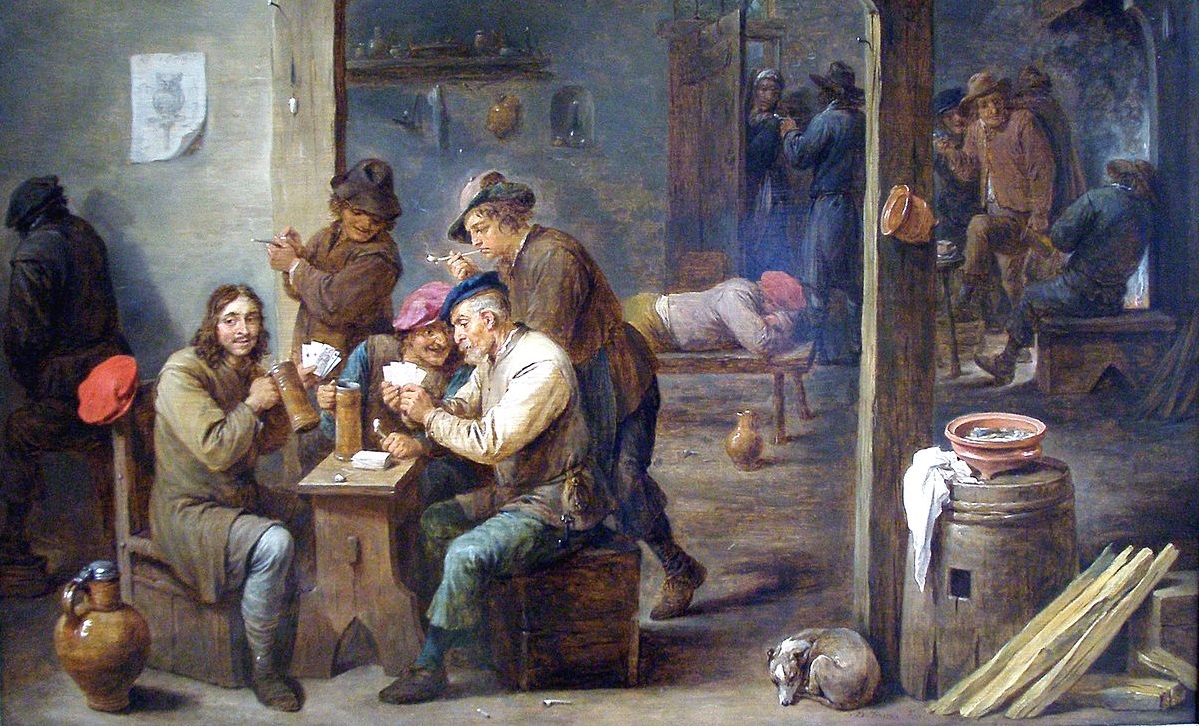
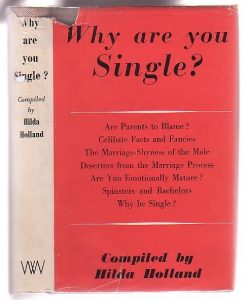 Looking back as recently as 1950 we have evidence of the shaming backlash against men who reject marriage and gynocentrism in the form of a book, “Why Are You Single?” a collection of essays compiled by Hilda Holland.
Looking back as recently as 1950 we have evidence of the shaming backlash against men who reject marriage and gynocentrism in the form of a book, “Why Are You Single?” a collection of essays compiled by Hilda Holland.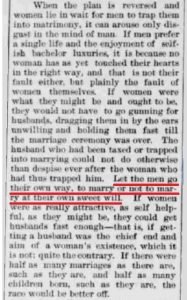
 Bachelorhood is surely one of the fine arts. No man becomes a bachelor other than by selection. A mere failure to connect on the matrimonial timetable does not constitute a bachelor! By no means. As well you might call a man a Frenchman who missed his steamer, thereby finding himself in France.”
Bachelorhood is surely one of the fine arts. No man becomes a bachelor other than by selection. A mere failure to connect on the matrimonial timetable does not constitute a bachelor! By no means. As well you might call a man a Frenchman who missed his steamer, thereby finding himself in France.”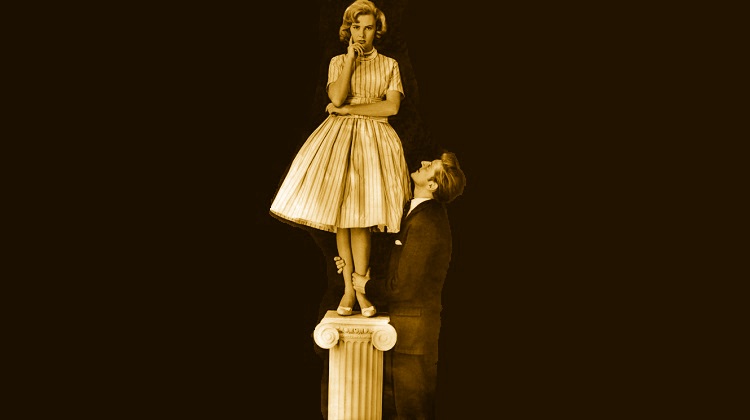
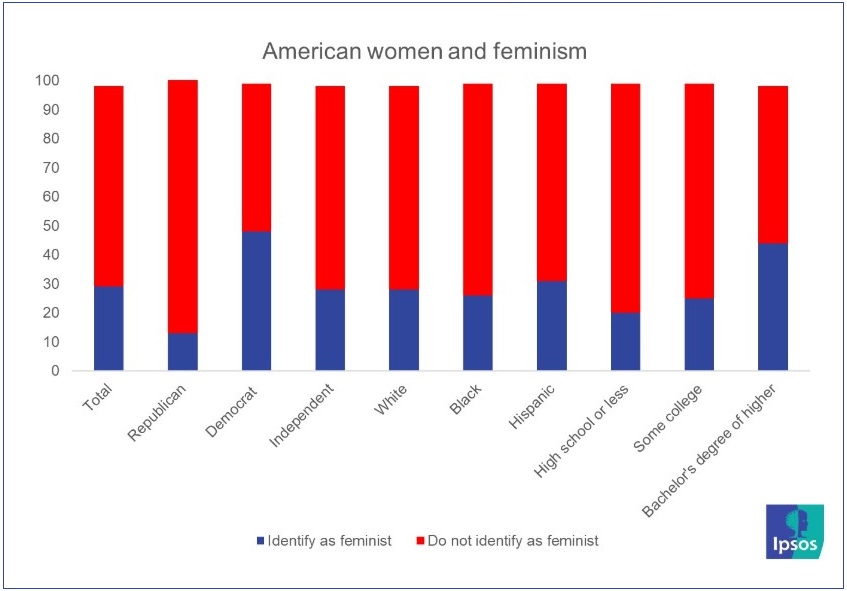
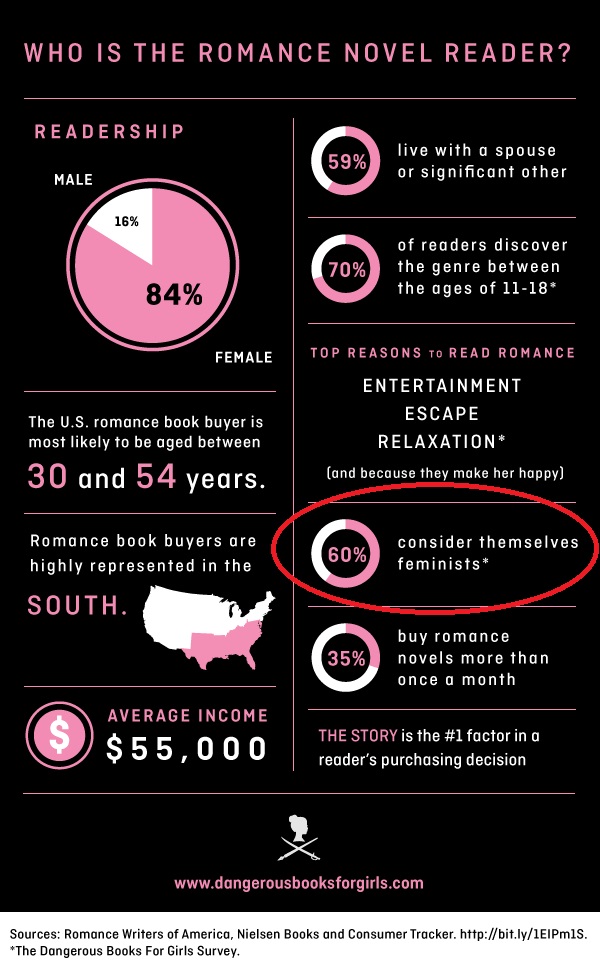
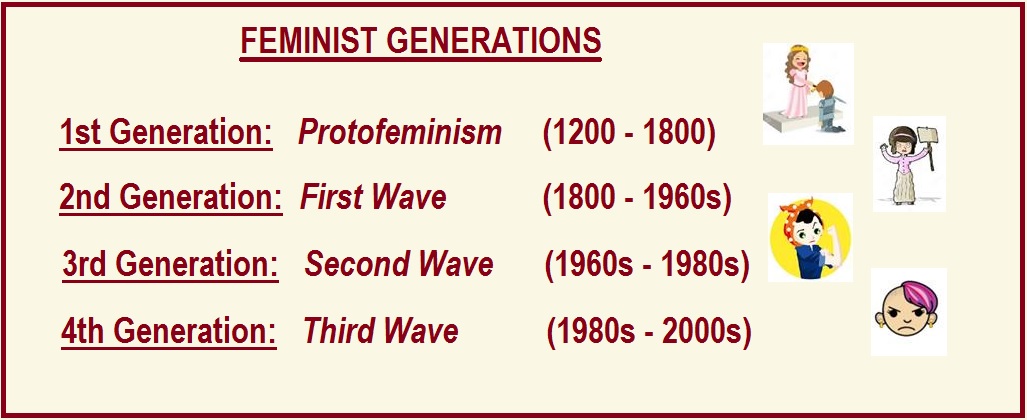
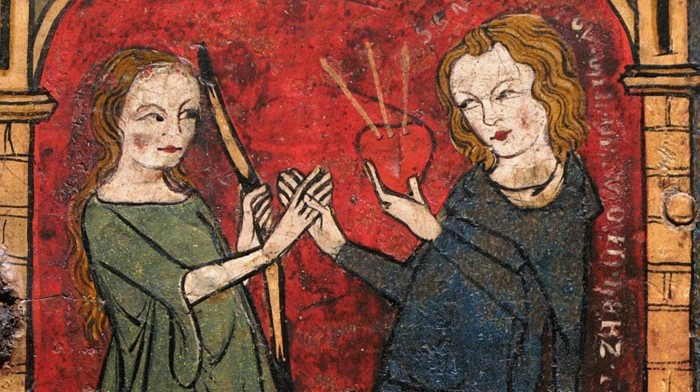

 To be sure, pen names are used for a variety of reasons. Some more high-toned female authors may use a pen name because they wouldn’t want their colleagues in academia to know that they dabble in such a low-status genre (though there are critics who assert that the only reason romance novels are lacking in prestige is because the genre is dominated by females). So it’s understandable that men who write romance novels would use some sort of female pseudonym. They don’t want their buddies to know what they’re doing, but more importantly, a prospective female reader might look askance at a paperback romance penned by a man. How could a male author create a believable heroine?
To be sure, pen names are used for a variety of reasons. Some more high-toned female authors may use a pen name because they wouldn’t want their colleagues in academia to know that they dabble in such a low-status genre (though there are critics who assert that the only reason romance novels are lacking in prestige is because the genre is dominated by females). So it’s understandable that men who write romance novels would use some sort of female pseudonym. They don’t want their buddies to know what they’re doing, but more importantly, a prospective female reader might look askance at a paperback romance penned by a man. How could a male author create a believable heroine?


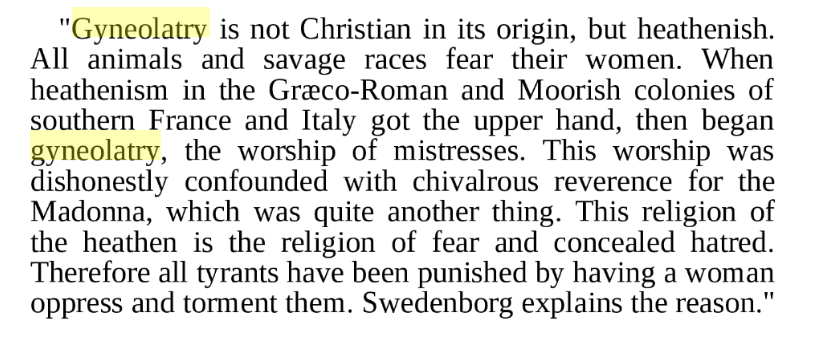

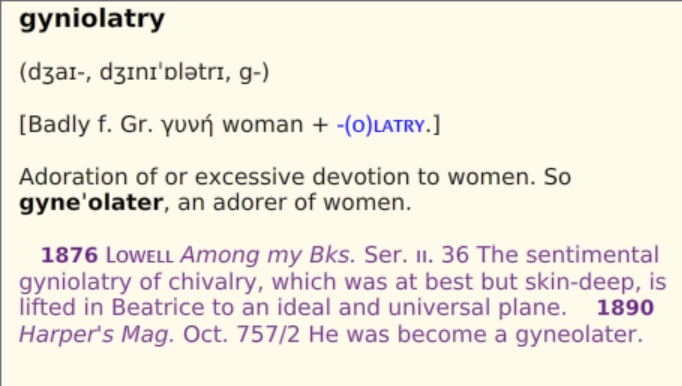

 ESTHER VILAR was born in 1935 of German parents in Buenos Ai- res, Argentina. She was trained as a physician and in 1960 went to West Germany to continue her Studies in psychology and sociology. She worked as a staff doctor in a Bavarian hospital for a year, and has also been a translator, a saleswoman, an assembly-line worker in a ther- mometer factory, a shoe model, and a secretary. She was married to German author Klaus Wagn for two years with whom she had a son.
ESTHER VILAR was born in 1935 of German parents in Buenos Ai- res, Argentina. She was trained as a physician and in 1960 went to West Germany to continue her Studies in psychology and sociology. She worked as a staff doctor in a Bavarian hospital for a year, and has also been a translator, a saleswoman, an assembly-line worker in a ther- mometer factory, a shoe model, and a secretary. She was married to German author Klaus Wagn for two years with whom she had a son.
